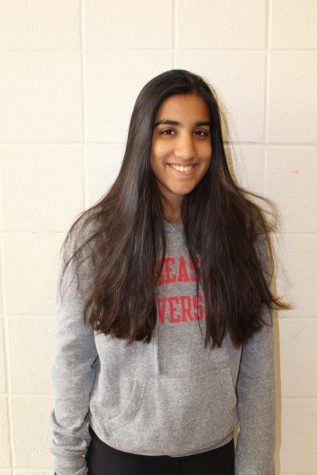
12
Why did you join the Black and White?
I wanted to become a better writer and learn more about my community.
What's your favorite scent?
Coffee

December 17, 2018
In 1970, almost 92 percent of MCPS students were white, according to a University of Denver graduate student project. But by the 2016-2017 school year, that number had dropped to around 28 percent, according to the MCPS At-A-Glance report. The county is a microcosm of the nation as a whole: by 2045, the nation is projected to become “minority white.”
Immigration has made Montgomery County, the 16th largest county in the nation, more diverse. Among D.C. suburbs, Montgomery County has the highest percent of residents who are foreign born, reported the Maryland Office of Policy analysis. The largest wave of immigration occurred between 1990 and 2010, found the Brookings Institute. Latin American immigrants accounted for the largest portion, according to the Montgomery County League of Women Voters.
As MCPS has become more diverse, it has also become more racially segregated. Although MCPS is diverse overall, a 2014 Office of Legislative Oversight report revealed that few schools reflect that diversity. ProPublica, a national investigative media outlet, reported that the segregation index in Montgomery County is “high.” From 2011 to 2015, just over 30 percent of students in the Takoma Park and Silver Spring area were white and just over 70 percent of students in the Bethesda and Potomac area were white, according to the Urban Institute.
This de facto segregation occurs because students with similar socioeconomic status are clustered together in the same schools. House prices and average income vary significantly within the county. In 2011, CNN ranked Bethesda as the highest earning town in the nation. Now, in 2018, Bethesda has a median family income of $146,664, and Silver Spring’s is nearly half that at $72,790. The Stanford Education Data Archive concluded that socioeconomic status is directly tied with academic achievement.
NAACP Parents’ Council co-chair Angela Jones said minorities face economic obstacles that have been perpetuated throughout history. The schools in lower-income areas—John F. Kennedy, Wheaton, Watkins Mill—have a majority of minority students. MCPS’ five top ranked schools, according to US News and World Report (Whitman wasn’t ranked), are all in higher income neighborhoods; they have a plurality of white students.
De facto segregation contributes to the opportunity gap, Montgomery County senior legislative analyst Elaine Bonner-Tompkins said. The opportunity gap is the way race and socioeconomic status create disparities in student achievement. Schools with the highest minority enrollment are in the lowest income areas, and as a result, lack funding for an enriched education. Black students are, on average, three grades behind white students, and Hispanic students are 3.2 grades behind, according to ProPublica.
“Schools at a Glance” reports from the 2017-2018 found Kennedy has the largest minority population percentage—over 95 percent—while Whitman is the least diverse school in the county, with a 66.8 percent white population. Kennedy’s average SAT scores are 300 points lower than Whitman’s, and their graduation rate is 14 percent less.
The opportunity gap extends beyond high school and affects students in college and in their careers, principal Robert Dodd said.
“If schools or communities don’t provide opportunities, then kids will naturally lack certain experiences that will potentially help them later in life,” he said. “If kids don’t get access to higher level courses, they could be less college or career ready.”
As the divide grows, students, parents and educators continue to ask themselves: how can we close the gap?
Although MCPS gives more dollars per pupil for enrichment programs to lower income schools, private funding though PTSAs, education foundations and parent booster organizations contributes to the gap.
Whitman’s PTSA raised around $74,000 in 2017, excluding its post prom funds. The Kennedy PTSA, though, raised about $6,000. The cost of joining the organization contributes to the funds raised, as it costs $15 for a parent to join the Kennedy PTSA while it costs $40 at Whitman.
Kennedy’s PTSA spent around $5,000 of that money on post prom, PTSA secretary Kelley Eiskant said, adding that this didn’t leave a lot of money for discretionary spending on additional school resources or staff development.
“We’re sorely underfunded,” Eiskant said. “The major thing that we really do every year is post prom, and ideally we would like to be able to support our staff members and students in other ways.”
Private funding at Whitman through the education foundation, PTSA and booster clubs contributes to professional development for staff, improved technology and extracurricular activities, Whitman’s PTSA secretary Neha Dhir said. Without such funding, many students from schools in lower income areas are at a disadvantage.
The Whitman High School Education Foundation raises funds from parent and community member donations. During the 2016-2017 school year, the Foundation raised $132,883, which it used to fund 44 new grants for programs, including purchasing 100 new Chromebooks, 3D printers for engineering programs, new furniture in the media center and new lighting consoles in the auditorium. These resources help students learn to use sophisticated technology and enrich their education outside of school—advantages that students at lower income schools don’t have. Some of the money is also used for professional development, which helps teachers enhance their skills to teach AP and other higher level courses.
In contrast, some MCPS high schools, including Wheaton, Springbrook and Albert Einstein, don’t have an education foundation at all.
Many downcounty schools don’t receive a lot of private donations since parents are often trying to make ends meet, English teacher Cody Therrien, who taught at Kennedy, said.
“There’s a lot more active engagement from the parents, and I think that’s due to economic factors generally speaking,” Therrien said. “A lot of my students at Kennedy—their parents were working several jobs. They didn’t have the money to donate, and they didn’t have the time to donate.”
When Therrien worked at Kennedy, he taught a student who easily earned a hundred percent on all of her progress checks. He was shocked to learn she lives in a basement with three other families. She was talented, he said, but he worried she wouldn’t reach her full potential.
The Black & White has a staff of 86 students in three class periods, with a budget that runs around $19,000 year. Ninety percent of its income comes from subscriptions, many of which are purchased by journalism parents who support the publication.
This magazine, for example, costs upwards of $2250 to print; The Black & White will spend about $10,000 on printing costs for the five tabloid and two magazine issues it will produce this year. Because this publication has the resources to produce high quality journalism, it wins national awards and increases recognition for student journalists, adding prestige to resumes before college applications and perpetuating the cycle of inequity. This opportunity is not an economic possibility for schools in low income areas.
Many downcounty students lack financial support to spend on extracurriculars, multiple SATs—the county funds the first one if taken during a school day—and school trips, but their family incomes make them ineligible for fee waivers, Eiskant said.
Montgomery Blair senior Kayla Malone is a member of the minority scholars program. She says this gap extends to academics as well.
“In my classes, I know a lot of other minority students that don’t want to take AP Calc because they don’t have the opportunity to get the tutor that a more privileged student can get,” she said. “They just don’t want to take the class because they feel threatened and don’t have the same opportunities,” she said
Many Kennedy students have learned to make the most of their circumstances, senior Kiera Hall said.
“We all try our hardest to succeed,” Hall said. “We make lemonade out of the sourest lemons that we are given.”
There’s no clear or easy solution to the opportunity gap. The MCPS Equity Initiatives Unit, which aims to eliminate racial predictability in student achievement, is working to narrow that gap by focusing on culturally responsive training for teachers. This practice emphasizes individual student needs, especially those of minority and immigrant students. The Board of Education is working to prevent further segregation and provide more support to level the playing field in early education.
This year, the Board passed Policy FAA, which specifies that if boundaries are redrawn, they cannot further segregate students. But it’s unlikely county officials will redraw boundaries to reduce de facto segregation, Board member Patricia O’Neill said. While the Board is considering redrawing adjacent boundary lines to fix issues with overcrowding, any future adjustments would keep students of similar socioeconomic status and race together.
As an initial strategy, MCPS is trying to close the gap early on by lengthening the school year from 180 to 210 days for two downcounty elementary schools. Students in lower-income areas often return to school at a disadvantage because they don’t have the opportunity to continue their learning during summer camps or travel, MCPS Public Information Director Derek Turner said.
Board member-elect Karla Silvestre believes increasing access to preschool is key. MCPS is already working on expanding the Head Start program from half a day to a full day, which helps low-income children prepare for kindergarten, she said.
“I feel like when you have a big problem, it’s really important to figure out where you can make the biggest difference and really focus relentlessly in that particular area,” Silvestre said. “More than half of MCPS kids are not ready for kindergarten, and that means the gap begins before kindergarten.”
Board member Jeannette Dixon wants quarterly reports to hold the Board accountable on closing the gap, she said.
“It should be something on the Board’s agenda to show that we are not just giving lip service to this, and it’s something that we really want to work on,” Dixon said.
Diversity in the classroom means teachers need to recognize students’ cultural norms. Equity Unit director Troy Boddy said adapting to students’ individual needs can help them feel more comfortable in that classroom. To that end, The Equity Unit has promoted culturally responsive training. This training helps teachers learn differences in cultural norms so they don’t punish a student for misunderstanding social and academic behaviors, Whitman staff development teacher Anne Chiasson said.
In schools in lower income areas, special programs enrich student learning or provide an alternative to college education. In 2004 the county created a downcounty consortium to promote school choice. In the consortia, each school has unique programs.
At Kennedy, students can choose from the International Baccalaureate program, the Leadership Training Institute, the Navy Junior Reserve Officers Training Corps, Broadcast Journalism Academy and Business Administration and Management Academy. These programs provide alternatives to typical classroom learning.
The opportunity gap isn’t confined to low-income areas. An opportunity gap also exists within Whitman, Dodd said. To address the gap Dodd said he wants to ensure all students have access to higher level classes, including AP classes, regardless of their background. He also wants to look in to a two-day college trip for students who don’t have the financial resources to visit colleges on their own.
“Education is very slow to change,” the Equity Unit’s Boddy said. “It’s a lot of heavy lifting, but it’s something that we are chipping away at. We want everyone to have the same opportunities and best curriculum, no matter who they are.
